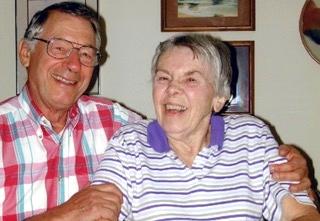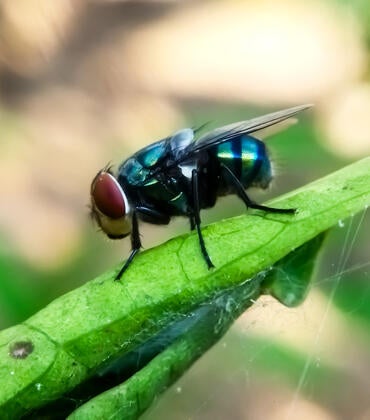
UC Riverside’s herbarium, established over 60 years ago, is an irreplaceable library of plant specimens.
Now, a $900,000 bequest from its founder Frank Vasek and his wife Maxine will ensure the resource remains available to many generations of future plant scientists, and that it receives needed repairs and reorganization.
Vasek, who started the herbarium with a massive investment of time, energy, and care, wanted to ensure its longevity. It is home to an impressive collection of more than 273,000 plants from the Western Hemisphere, from Alaska to Tierra del Fuego, some of which are now extinct in the wild. But this collection had a very humble beginning. Asked about its significance for botanical research, herbarium curator Andrew Sanders explained, “We’re the stockroom clerks of the biosphere.”
When Vasek arrived in 1954 — the same year classes first began at UCR — it was supposed to have been on a part-time, temporary basis. An expert in California flora, Vasek was finishing his dissertation when he was hired to teach field botany.
Because the campus was in its nascent stages, the resources he needed for research hadn’t been established yet.
“I became concerned about how I’d teach my course with no herbarium for students to consult,” Vasek said. “It’s a necessary tool for a research scientist, every bit as essential for a botanist as a library is to other types of scholars at a university.”
To fill the gap, Vasek required each of his three students that year to collect 50 plants. At the end of the semester, they donated these collections to Vasek’s metal office storage cabinet, where the herbarium resided for several years.
Visitors will now find a dedicated herbarium space in the southeast corner of campus. But getting it to grow from its initial iteration to its current status as the fourth largest collection of California plants in the world was no easy task.
In those early years, Vasek had to balance building the herbarium with a full load of teaching, conducting botanical taxonomy research, getting published, and trying to become a full-fledged professor.
He also spearheaded the not-small task of establishing the UCR Botanic Gardens, overseeing the first plantings at the 4-acre property, and serving as its first director. Vasek compared his juggling act in those days to being a parent.
“Doing all of that, it was trying at times,” he said. “One doesn’t go through an intense struggle without becoming attached to it — attached for life. I look upon the herbarium as one of my children.”
The analogy is borne of personal experience. Frank and Maxine’s oldest daughter, Cheri, graduated from UC Davis; and the youngest, Cynthia Engel (formerly Vasek), holds three degrees from UCR.
The Vasek family’s campus legacy has many tendrils. Maxine served two years as a graduate plant anatomist, and then worked as a laboratory technician in UCR’s Department of Microbiology and Plant Pathology.
Before being hired 40 years ago as the herbarium curator, Sanders was one of Frank Vasek’s students.
“I was always deeply impressed by him,” Sanders said. “He was friendly and encouraging even though he was also scary intelligent.”
Vasek’s prolific career as a research scientist resulted in 50 technical papers and another 50 articles authored for various organizations. However, his own work never came at the expense of his teaching.
“The way Dr. Vasek ran his classes really forced you to think,” said Sanders, noting Vasek challenged him in the best ways during his time as a student in the 1970s. “He was never into rote memorization. He encouraged looking deeply at the natural world and seeing the similarities in the structure of things.”
“He was very committed to education and put a lot more emphasis on teaching than many professors I knew,” Sanders said. “I believe that’s why he’s supporting the herbarium today — it is so key for student learning.”
The herbarium is also a resource for the general public, consultants, and various agencies with questions about plants. Anyone can bring in material and have it identified. Sanders and the rest of the staff are also working to get the entire collection photographed, associated with the correct records, and posted online.
Though there are resources online that can assist with casual plant identification, none of these could replace the herbarium.
“Many online services have tons of misinformation. They aren’t reliable. It’s much better to have a physical collection, which can be checked,” Sanders said. “Also, nobody’s yet worked out a way to extract DNA from digital records.”
The collection boasts many examples of native plants that cannot be found locally anymore, specimens that never used to be seen in North America, and some thought to have gone extinct that were rediscovered.
In addition to assisting with identifications, the staff prepare specimens for inclusion in the collection every day, Sanders said. Vasek’s donation will ensure this work can continue well into the future.
Patricia Springer, professor and chair of UCR’s Department of Botany and Plant Sciences, said the herbarium is an indispensable resource both for the campus and the general public.
“The extensive collection of Southern California plants provides a catalog of rare and endangered species and plays a critical service in identifying plants for the public,” Springer said. “We are so grateful to the Vaseks for this generous gift.”
The bequest is all the more meaningful now as the world navigates such uncertain times. It will ensure this institution, which Vasek worked to raise as if it were one of his own children, will continue helping scientists gain a deeper understanding of the environment.
“The herbarium is an active, lively, and productive operation,” Vasek said, “That’s what I like, and that’s how I want it to stay.”




